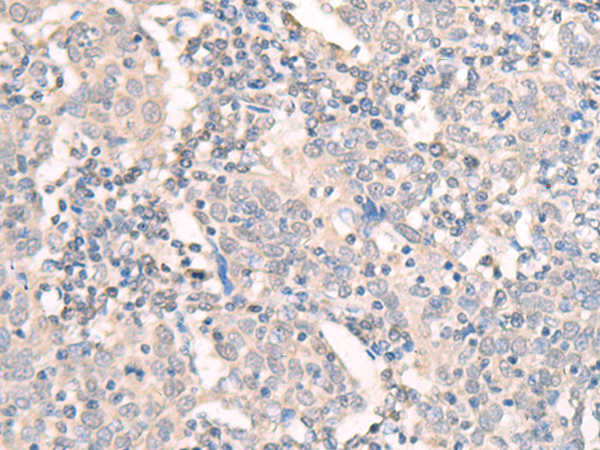
| WB | 咨询技术 | Human,Mouse,Rat |
| IF | 咨询技术 | Human,Mouse,Rat |
| IHC | 1/30-1/150 | Human,Mouse,Rat |
| ICC | 技术咨询 | Human,Mouse,Rat |
| FCM | 咨询技术 | Human,Mouse,Rat |
| Elisa | 1/5000-1/10000 | Human,Mouse,Rat |
| Aliases | LPLUNC1; C20orf114 |
| Host/Isotype | Rabbit IgG |
| Antibody Type | Primary antibody |
| Storage | Store at 4°C short term. Aliquot and store at -20°C long term. Avoid freeze/thaw cycles. |
| Species Reactivity | Human |
| Immunogen | Fusion protein of human BPIFB1 |
| Formulation | Purified antibody in PBS with 0.05% sodium azide and 50% glycerol. |
+ +
以下是关于BPIFB1抗体的3篇参考文献的示例(内容为模拟概括,非真实文献):
1. **文献名称**:*"BPIFB1 modulates innate immune responses in airway epithelium"*
**作者**:Smith A, et al.
**摘要**:研究利用BPIFB1抗体通过免疫组化和Western blot技术,发现BPIFB1在呼吸道黏膜中高表达,并参与调控TLR信号通路,可能通过抗菌肽分泌增强宿主防御功能。
2. **文献名称**:*"BPIFB1 as a potential biomarker in oral squamous cell carcinoma"*
**作者**:Chen L, et al.
**摘要**:通过免疫组织化学分析(使用BPIFB1特异性抗体),发现BPIFB1在口腔癌组织中表达显著下调,且低表达与患者预后不良相关,提示其可能作为肿瘤抑制因子。
3. **文献名称**:*"Proteomic characterization of BPIFB1 in human saliva"*
**作者**:Wang X, et al.
**摘要**:研究采用BPIFB1抗体进行质谱分析和ELISA,揭示了BPIFB1在唾液中的特异性分布及其与口腔微生物群的相互作用,为口腔免疫机制提供了新见解。
**注意**:以上为模拟文献,实际引用需查询PubMed、Google Scholar等平台获取真实研究。
The BPIFB1 (BPI fold-containing family B member 1) antibody is a tool used to detect the BPIFB1 protein, which belongs to the bactericidal/permeability-increasing protein (BPI) family. BPIFB1. also known as LPLUNC1. is encoded by the *BPIFB1* gene located on chromosome 20q11.21. This protein is primarily expressed in mucosal epithelial tissues, including the respiratory tract, oral cavity, and nasopharynx, suggesting a role in innate immunity and host defense. Structurally, it contains a characteristic BPI fold, which facilitates lipid-binding activities, potentially targeting bacterial lipopolysaccharides (LPS) to neutralize pathogens or modulate inflammatory responses.
Research highlights BPIFB1's involvement in chronic inflammatory diseases, such as sinusitis and cystic fibrosis, where its expression is often dysregulated. It may also play a dual role in carcinogenesis, acting as a tumor suppressor in certain cancers (e.g., nasopharyngeal carcinoma) while promoting cell survival in others. The BPIFB1 antibody is widely utilized in techniques like immunohistochemistry (IHC), Western blotting (WB), and immunofluorescence (IF) to study its localization, expression patterns, and interactions in disease models. Recent studies explore its potential as a diagnostic or prognostic biomarker, though its precise molecular mechanisms remain under investigation. Commercial antibodies vary in specificity, requiring validation via knockout controls or peptide-blocking assays to ensure reliability.
×